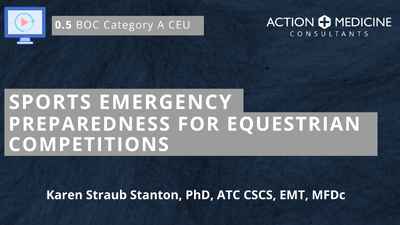Course Info (BOC Domains of Athletic Training; Presentation Description; Learning Objectives; Clinical Practice Gap Statement; Clinical Bottom Line)
BOC Domains of Athletic Training:
- Domain III - Critical Incident Management
Presentation Description:
This session focuses on the critical aspects of sports emergency care specific to equestrian events. Attendees will gain insights into the essential emergency care equipment required, the development and implementation of venue-specific Emergency Action Plans (EAPs), and the management of common and catastrophic injuries in equestrian sports. Through a rapid-fire discussion, participants will explore unique challenges and strategies for effective emergency response in this specialized field.
Learning Objectives:
- Identify essential emergency care equipment specific to equestrian events and understand the protocols for ensuring its availability and readiness during competitions.
- Identify components of venue-specific Emergency Action Plans (EAPs) for equestrian sports, addressing unique challenges and environmental considerations
- Identify strategies for managing typical rider injuries and preparing for potential catastrophic injuries, including effective on-field management and communication protocols with equestrian staff and medical teams.
Clinical Practice Gap Statement:
Equestrian sports present unique challenges for emergency medical care that are not commonly encountered in other athletic settings. Many athletic trainers and emergency care providers lack specific training and experience in managing emergencies in equestrian environments. This gap in knowledge and preparedness can lead to inadequate emergency response, potentially compromising the safety and well-being of athletes. Addressing these gaps through targeted education and training is essential to improve emergency care outcomes in equestrian sports.
Clinical Bottom Line Statement:
Improving emergency care in equestrian sports requires a comprehensive understanding of the specific equipment needs, effective implementation of venue-specific Emergency Action Plans (EAPs), and preparedness for managing both common and catastrophic injuries. By addressing these unique challenges and enhancing the training of emergency care providers, we can ensure better safety and outcomes for athletes participating in equestrian events.


